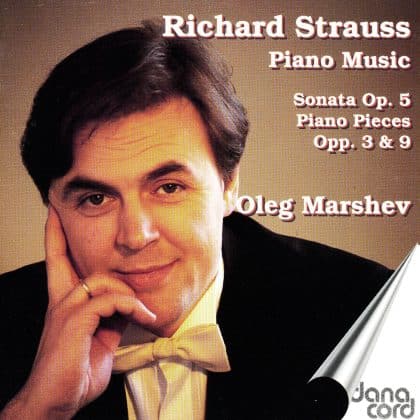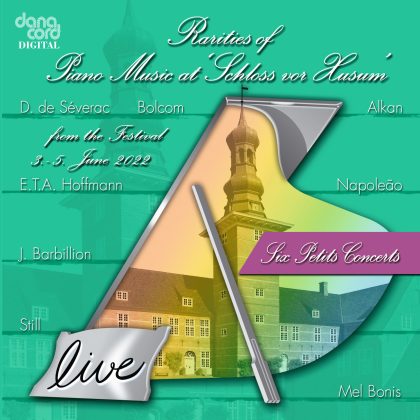Maurice Ravel
1. Sérénade grotesque
2. Menuet antique
3. La Parade
4. Pavane pour une infante défunte
5. Jeux d’eau
6. Menuet in C sharp minor
Miroirs:
7. I. Noctuelles
8. II. Oiseaux tristes
9. III. Une barque sur l’océan
10. IV. Alborada del gracioso
11. V. La vallée des cloches
12. Fugue in F Major
Maurice Ravel ©
by Peter Quantrill
Writing on the centenary of the birth of Maurice Ravel in 1975, the late composer Ned Rorem stated, ‘Of those composers I most love, Ravel is the single one through whose sound I feel the man himself. No other composer pulls quite the same trick.’ This quality – music as the mirror of the soul, perhaps, whether or not he believed in souls – marks out Ravel’s apparent failures as much as his successes. In 1905 he made the last of his five attempts to follow in the footsteps of Berlioz, Bizet and Debussy to win the prestigious Prix de Rome. By then he had under his belt several widely praised (and published) pieces (Jeux d’eau, a string quartet which had been extravagantly praised by Debussy and the orchestral song cycle Shéhérazade) and only a tenuous connection with the Conservatoire and after. It might be said that, as a composer, he had nothing left to prove. He was also temperamentally unlikely to succeed in a competition in which strict adherence to the rules of composition was paramount and which was usually won by composers of modest imagination.
Ravel’s output, on the other hand, demonstrates a curious blend of the two elements identified by the poet Apollinaire as being vital for creation: what he called ‘ordre’ and ‘aventure’. The composer’s passion for order, whether in the shape of inherited forms (even the fugue) or the dance, vies with his continual search for new things, as evidenced in his occasional boast ‘and then, you know, no one had ever done that before’ (et puis, vous savez, personne n’avait fait ça).
With this final attempt, Ravel failed even to progress beyond the preliminary writing of a fugue, although his decision to end it with a forbidden seventh suggests he may have been courting failure. A composer of his stature and originality being rejected year after year by the French musical establishment became a public scandal. ‘L’affaire Ravel’ ended with the resignation of the Conservatoire’s director, Théodore Dubois, and his replacement by Fauré. Meanwhile, Ravel himself was putting the finishing touches to an elegantly Classical Sonatine that might have satisfied the stuffiest of the Prix de Rome judges, bearing as it does ‘the double imprint of youth and mastery’ in the phrase of his early biographer Alexis Roland-Manuel.
The Sonatine began life with a single sonata-form movement, written in 1903 as an entry to a competition sponsored by a weekly critical magazine. Nothing came of this as the magazine went bankrupt (with Ravel the only entrant) but over the next two years he added two more movements, and the final work became his first piece in Auguste and Jacques Durand’s catalogue. The first movement is developed Classically with statements of two contrasting subjects, each of which opens on a falling fourth, followed by a development section which builds to a passionate climax and a short recapitulation ending dangerously on a chord of the seventh (like the final Prix de Rome fugue).
Ravel cautioned against playing the following Menuet ‘too spikily’ and recommended a tempo suitable for Beethoven’s Sonata Op 31 No 3. The second theme of the minuet is derived from the opening of the first movement and unfolds simultaneously with its own augmentation. The concluding Animé also includes a passing recollection of the first movement’s pastoral mode, but the movement is one of his first examples of an irregular moto perpetuo which reaches its apotheosis with the ‘Scarbo’ finale of Gaspard de la nuit. Alfred Cortot could have had this finale in mind when he remarked that ‘Ravel does not allow any licence, he’s not like Debussy. You have to play him sitting up straight, to produce a forceful sound and create a precise colour made up of transparency, clarity and rhythmic uniformity, in the interplay of sevenths and ninths.’
A second Menuet: marking the centenary of Joseph Haydn’s death in January 1910, La Revue Musicale of the Société Internationale de Musique published a collection of tributes, commissioned from Debussy, Ravel, Dukas, d’Indy, Hahn and Widor, expeditiously reprinted by Durand a month later. All six tributes were based on the translation into pitches of the HAYDN motif, B-A-D-D-G, (where German H=B natural, and Y and N are obtained counting alphabetically from A). Consciously implementing some common Renaissance composition procedures that Haydn was also fond of, Ravel – albeit in a concealed fashion – used the main motif in retrograde and inversion as well.
Having made an 18th-century dance form his own in these menuets, and written extensively about dancing and dancers in the Parisian press, Ravel was a natural choice for Serge Diaghilev when seeking to commission new works for his Ballets Russes company. His resident choreographer Michel Fokine recollected the genesis of Daphnis et Chloé: ‘The rather youthful Ravel… was not yet the famous master, the leader of the modern French composers, which he was destined to become later.
He invited me to his house to get acquainted with his music… I was delighted that a musician of such talent was going to write music for my Daphnis ballet, and I felt that the music would be unusual, colourful and, most important, what I sincerely wished – totally unlike any other ballet music.
‘I brought [the designer Leon] Bakst along to our next meeting to act as my interpreter, as my French at that time was not very fluent. I related to Ravel the libretto of Daphnis et Chloé and told him how I saw the action and visualized the music. I expressed my belief in the necessity of uninterrupted movement and the unity of the performance as a whole, and spoke of my wish to avoid separate numbers; also the desirability – even in part – of communicating that character of the music of antiquity, and so forth.’
Ravel fulfilled Fokine’s brief but he found the work hard going, and the premiere of the ballet had to be put back a season. Even once it was ready, Diaghilev had misgivings about the undramatic nature of the result – inherent in the original story from Longus, but also reflected in Ravel’s designation of his score not as a ballet but a ‘symphonie choreographique’. The composer wrote with his own aim to mind, to evoke ‘the Greece of my dreams, which is not unlike that imagined and depicted by French artists at the end of the 18th century.’ After the premiere in January 1912, he extracted three episodes from his piano reduction (made for rehearsal purposes) of the full-orchestral score, though they have never enjoyed the popularity of the two Daphnis suites for orchestra.
Gaspard de la nuit brings us to the climax of Ravel’s piano writing – and to a summit of the entire piano literature for many pianists and listeners. Once again the subtitle is instructive: ‘Trois Poèmes pour Piano d’après Aloysius Bertrand’, and Durand published the score with the relevant texts prefacing each movement: firstly ‘Ondine’ with the dedication ‘À Harold Bauer’, then ‘Le Gibet’, which was assigned to Jean Marnold, and finally ‘Scarbo’ for Rudolph Ganz. Bauer and Ganz were excellent pianists who made Ravel’s works known in Europe and the US, while Marnold, as a music writer and critic, had drawn attention to Ravel early on; he wrote, for example, in the Mercure de France of April 1904: ‘Il faut retenir le nom de Maurice Ravel’.
In writing the collection of prose poems which supplied Ravel with his title, Bertrand had been inspired by nocturnal scenes painted by Callot and Rembrandt: snapshot-like impressions of phantasms cast in half-light. He was interested in daguerrotype, the predecessor of modern photography today, and likewise sought to capture images of life in a fluid form. Although Ravel’s music refers to Bertrand’s poems only in allusive terms, they share qualities of the fantastic, the whimsical and nocturnal loneliness.
Another early biographer of the composer, Marcel Marnat, claimed that it was the condition of Ravel’s slowly dying father which prompted the composition of Gaspard. To draw a parallel with a contemporary French artist whose closest enduring relationships were with his parents, there is a Proustian detail and hypersensitivity to this music, in which trickles and murmurs become screams and morbid apparitions in a trice.
Bertrand cast ‘Ondine’ in two parts: in the first we hear the voice of Undine, who tells of her life and her clan of water spirits, in the second part it is only briefly mentioned that the water mermaid wanted to mate with the poet to make him king of the lakes. While the first part is in direct speech, in the second it is indirect; no dialogue takes place between the water spirit and the man. Thus Ravel’s music embodies a ‘chanson murmurée’, as it says in the penultimate stanza. This ‘murmuring song’ pervades the piece as a whole; a delicate and simple melody is surrounded by unaccompanied fioriture. Violent accents are also forbidden, because Undine’s grief at the refusal of man to go with her is short-lived and immediately turns into laughter. She became a fruitful subject for the Art Nouveau style, in which her long, flowing hair is transformed into waves and cloud formations.
‘Le gibet’ translates Bertrand’s macabre vision with unsparing directness: ‘It is the bell that rings on the walls of a city below the horizon, and the carcass of a hanged man reddened by the setting sun.’ What is astonishing is how Ravel has sublimated the horror: only the tolling bell is heard, a single note around which dusky chords gather; the piece stagnates and ebbs away just as it began. Its fantastical nihilism evokes the poetry of Mallarmé and Rimbaud as much as Bertrand – and, with Marnat’s thesis in mind, the slow death of Ravel’s father, who, cerebrally paralyzed, no longer recognises his son.
The ‘Scarbo’ imagined by Bertrand is a goblin-like wraith who disturbs the fitful sleeper (Ravel suffered chronic insomnia). He is everywhere and nowhere, and becomes diaphanous towards morning, then vanishes into thin air. With the outbreak of the movement’s main melody, however, Ravel’s music leaves behind the horrors of the sometimes stark text and creates its own realm of enchantment and magic, a ne plus ultra in the line of Lisztian transcendental studies, and a window on to an ordered and disturbed mind. Through its sound we may feel the man himself, as Rorem remarked.
RELEASE DATE: April 2022
CATALOGUE NUMBER.: DACOCD 903
EAN: 5709499903001




